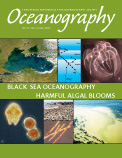First Paragraph
Uppermost Holocene (Unit 1) microlaminated sediments of the deep central Black Sea, which accumulate at ca. 0.02 cm/y, are a classic natural laboratory for exploring geochemical proxies used to identify ancient euxinic (anoxic and sulfidic) environments. By contrast, the physical and geochemical properties of black euxinic muds on the basin margin are controlled primarily by sedimentation rates that exceed 0.7 cm/y. Here, in this shallower environment, the iron and molybdenum concentrations approximate those of the continental source and adjacent oxic shelf, and degrees of pyritization fall between those of the oxic shelf and deep euxinic basin. Sulfur isotopes are shifted away from the extreme 34S depletions that characterize pyrite formed in the water column, as iron sulfide formation becomes more dominantly a diagenetic process. Organic carbon concentrations are driven low by clastic dilution, despite organic accumulation rates that greatly exceed those in the deep basin. Finally, reworking of CaCO3 and organic matter on the proximal shelf yield radiocarbon profiles strongly overprinted with old carbon, thus impacting the overall microbial reactivity of the organic matter and yielding 14C accumulation rates that are inconsistent with trends for the short-lived radionuclides, such as 210Pb, and the overall properties of the sediment. These exceptions to the oft-cited Black Sea model for ancient organic-carbon and trace-metal enrichment illuminate the strengths and weaknesses of certain paleoenvironmental methods and define a poorly known, rapidly accumulating black shale facies that occurs along the margins of modern, and likely ancient, oxygen-deficient basins.

